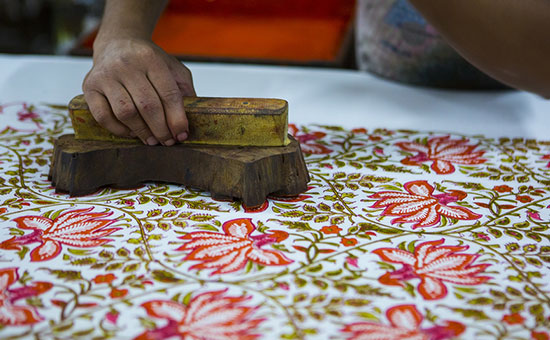The fashion world today is a hive of activity, only ridden by the quick trends of fast fashion. As a result, there exists a treasure trove that will last longer than your style does. These homegrown brands are an essential piece of the customary thing by any means, as their innovative looks decent the signature Hand Block prints. The rest of the article is devoted to the detailed study of hand block printing as a type of art in the tradition of textiles. It plays a significant role due to its sophistication, precise specifications, completed product, and distinguishing features.
Table of Contents
Having a Peek at Handmade-Block-Print.
Before plunging into the phenomenal world of Block Printing, you need to first grasp what this craftwork means. Very basically, it is a silkscreen where shapes of different colors are filled into a woodblock and then printed onto the fabric with the help of these figures. Terminologies like “Hand Block Printing” or “Hand Blocked Pattern” are generally used as a synonyms along with Block Printing (alala wala). Nonetheless, this art form covers stages more than only embossing designs in fabric-board carving, block preparation, and dye-making for fabric coloring. Different ways of Block Printing lead to unique skills, artistic virtuosity, and perseverance of sustained force, that produce prints of the greatest caliber and outstanding quality.
Tracing the Roots: One of the most striking aspects of the European Union is its ability to learn from the past.
The oldest technique Block Printing is known to be from China around the 3rd century, and it is about 2000 years old With every continent passing in it, it rather escaped almost unrecognizable in the Indian artisans’ hands. Rajasthan’s Chippa community and Khatris along with them introduced Rajasthan to this centuries-old art form. The origins of these unique prints lay in small places like Bagru, Sanganer, and Barmer where goods derived from local dyes were influenced by large-scale trading. By this means, Rajasthan has become one of the main economic centers in the world for these amazing handicrafts.
Diversity in Design: The art form of Block printing has different shades in India.
One of the most plentiful branches of printmaking, Block Printing in India, is found in a variety of regions of the country providing different styles of the craft. One selected the major and distinguished examples of compromises of Kalamkari Prints, Bagru Prints, Ajrakh Prints, Dabu Prints, and Sanganeri Prints. Despite having one primary state of origin, Rajasthan, separating bindiwork from heels is not an easy task as it is often a result of variations in printing techniques and color choices. As specific exemplifications, having a differentiating factor of a Sanganeri Print and a Bagru Print involves examining the background and design colors; a light background represents a Sanganeri Print, while a dark background points Bagru Print.
The Artistic Symphony: Hand Block Print Fest
Hand Block Printing is a fine intricate way of working, which suggests elegance and beauty. The key steps in this intricate art form include: The key steps in this intricate art form include:
1. Carving the Woodblock:
The first material to work on is the manual carving into the wooden block. This process requires sharp, steady, and finesse skills as carvers hammer sturdy steel chisels on tuned Sheesham wood to create textures and various designs. At the same time, most of the time clarity is the most important factor among all the other factors I consider.
2. Preparing the Woodblock:
Next, the wooden blocks are soaked in mustard oil which is an acid oil that is used to improve the quality of wood block printing by preventing bending and twisting. The artsmen would then make holes in the regions that were meant for applying the color and in the process stuff the holes with cotton to achieve even application. Each one of the blocks is purposed to a specific color so even fabric boarders also come in at least one color, which needed a separate set of wooden blocks.
3. Getting the Fabric Ready:3. Getting the Fabric-Ready:
When the cloth gets to the point blank, it is first soaked in a gentle bleach mixture, then in the vats. The process of unwinding this material then involves passing it through rollers to get rid of any excess dyes and the end product is dried on bamboo frames under Rajasthan’s hot weather. Following the ironing out, it gets fitted to the desired length, then it is pinned on the tables for being printed which takes no time.
4. Recipe of the Colors:
You ought to detect the suitable dyestuffing precisely. Some use the quick coloring process, while others prefer creating colors from natural sources like vegetables. The dyeing tray, a wooden tray with layered fabrics, is a central tool that makes it possible to get the right ink shades during the printing process.
5. Technique of Block Printing:
Artisans traditionally have an approach called “exterieur-dedans”, starting by printing borders and then to the main design. Wooden blocks used in woodblock printing are composed of a variety of sculptures, most of which are registration marks used for precise positioning. The next step is the outline filled with uncolored paint, and the papers are repositioned for sequential printing.
6. Final Touches:
Tiling tops of Rajasthan’s houses simultaneously serve as a sun-drying stage, where clothes are made to age for days in an aimless manner. Thereafter, the treated fabrics are washed twice to fasten the color tones. It goes through a series of tests comprising stitching, ironing, and labeling that the final product undergoes before it becomes saleable.
Preserving Tradition:
The Blockprints of India bear a special cultural and historical translucent manner. The painstaking pattern of traditional art handed from generation to generation signifies the Arab’s long-term ability to maintain the traditional arts. Hence, the prints of Rajasthan’s Dabu and Gujarat’s Ajrakh not only suggest the country’s wealth of its heritage but also show India as the major manufacturer and supplier of block-printing fabrics that have stood the test of time.
The beauty of Hand Block Printing lies in its timelessness which stands against the dynamic nature of fashion. Still, it wowed the world as a showcase of craftsmanship, tradition, and purposeful artisan creations. While we witness a constant change of fashion trends let us give homage to the legacy of Hand Block Printing which existed as early as and the one that doesn´t follow trends but takes the story of cultural richness and artistic creativity further.
















